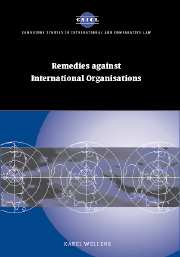Book contents
- Frontmatter
- Contents
- Acknowledgements
- List of abbreviations
- Introduction
- Part I General features of remedies against international organisations
- 1 The accountability regime for international organisations
- 2 Remedies against international organisations
- 3 The different levels of accountability and the appropriateness of various remedies: scope ratione materiae
- 4 Access to remedies
- 5 Remedies against whom: the scope ratione personae respondentis
- 6 The potential outcome of remedies: scope ratione remedii
- Part II Procedural aspects of remedial action against international organisations
- Part III Substantive outcome of remedial action against international organisations
- Part IV Alternative remedial action against international organisations and options for the future
- Conclusion
- Bibliography
- Index
- CAMBRIDGE STUDIES IN INTERNATIONAL AND COMPARATIVE LAW
3 - The different levels of accountability and the appropriateness of various remedies: scope ratione materiae
Published online by Cambridge University Press: 13 July 2009
- Frontmatter
- Contents
- Acknowledgements
- List of abbreviations
- Introduction
- Part I General features of remedies against international organisations
- 1 The accountability regime for international organisations
- 2 Remedies against international organisations
- 3 The different levels of accountability and the appropriateness of various remedies: scope ratione materiae
- 4 Access to remedies
- 5 Remedies against whom: the scope ratione personae respondentis
- 6 The potential outcome of remedies: scope ratione remedii
- Part II Procedural aspects of remedial action against international organisations
- Part III Substantive outcome of remedial action against international organisations
- Part IV Alternative remedial action against international organisations and options for the future
- Conclusion
- Bibliography
- Index
- CAMBRIDGE STUDIES IN INTERNATIONAL AND COMPARATIVE LAW
Summary
Generally speaking, the effectiveness of a remedy has to be tested by using criteria such as the independence of the decision-maker from the respondent authority (institutional effectiveness) and an element of enforceability (remedial effectiveness), thus excluding mere advice to the ultimate decision-making body.
In order to be both effective and dissuasive, remedies of whatever kind have to be appropriate given the interests they are aiming to protect or restore. Accordingly, the scope ratione materiae of remedies against international organisations has to match so as to be in harmony with the various components or levels of accountability as they have been described in the ILA Committee's First Report. On the first level, international organisations are subject to forms of internal and external scrutiny and monitoring when they are fulfilling their responsibilities as laid down in their constituent instruments. This monitoring takes place irrespective of potential and subsequent liability and/or responsibility. On the second level, tortious liability for injurious consequences may arise from a variety of acts or omissions. Damage may have been caused without violation of any rule or norm of international and/or institutional law. On the third level, organisational responsibility may arise from acts or omissions in breach of a rule or norm of international and/or institutional law.
A distinction has to be drawn between institutional acts and operational activities because potential claimants, their locus standi or lack of it, the applicable law, the mechanisms of redress and the nature of the remedy will necessarily be different.
- Type
- Chapter
- Information
- Remedies against International Organisations , pp. 28 - 35Publisher: Cambridge University PressPrint publication year: 2002

